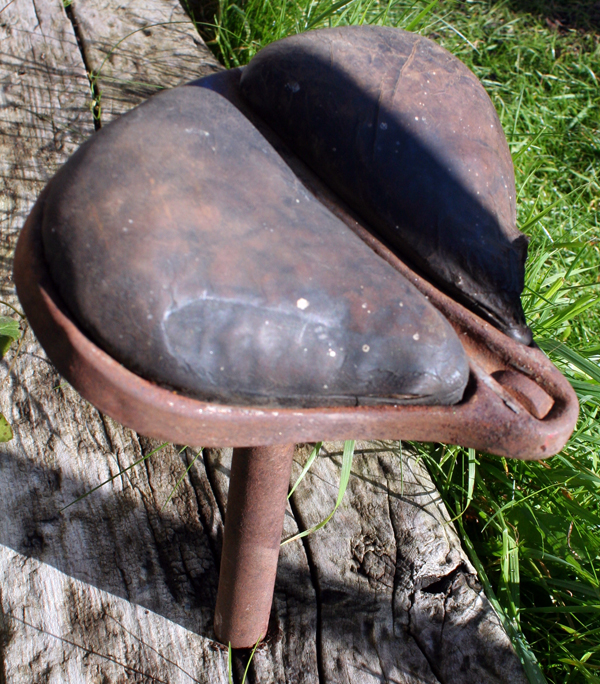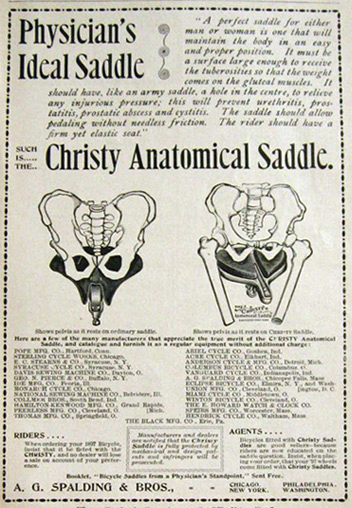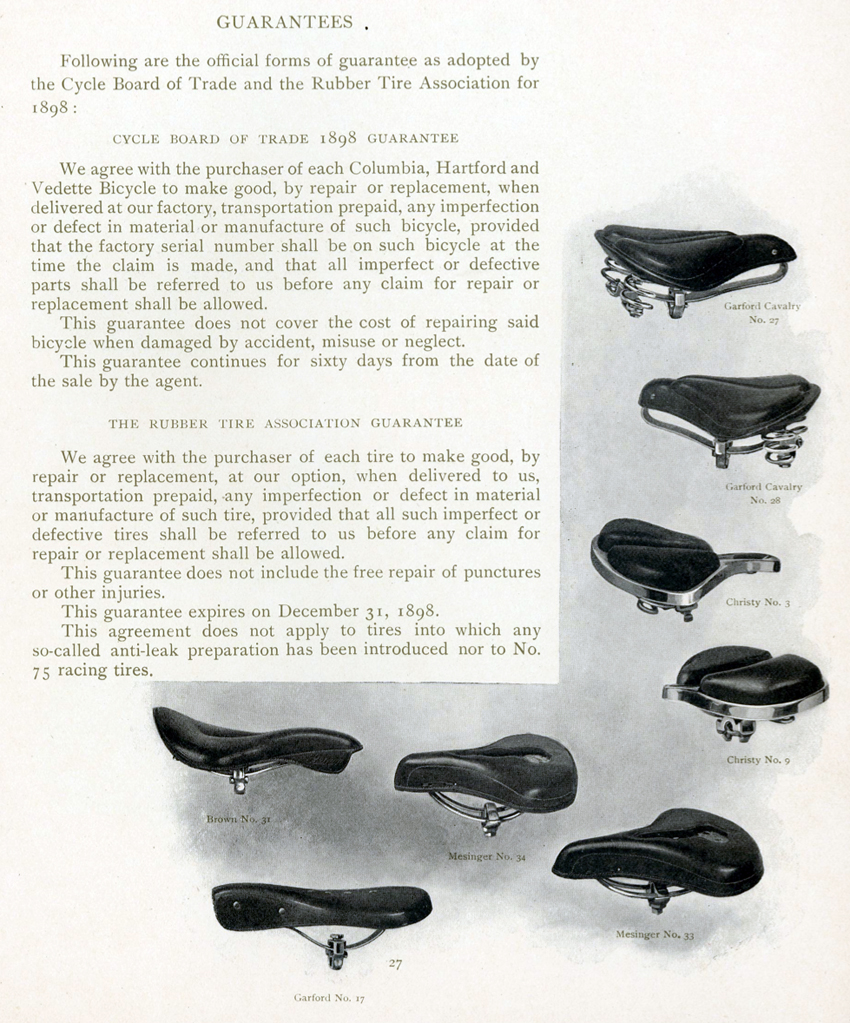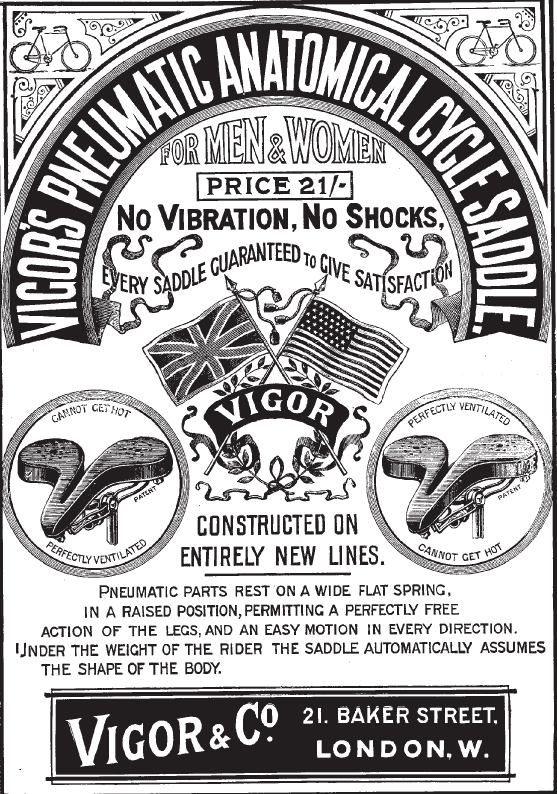
1898 CYCLE SADDLES:
The Anatomical Saddle
No saddle is perfect. The perfect saddle, as the public looks at it, is the saddle that fits everybody. It will never be made, for people are different. The true wisdom of saddle buying is to get one that will fit you. Choose a saddle as you choose a pair of shoes. Wrong shoes cause corns. So do wrong saddles. Saddle corns are decidedly uncomfortable.
During the season of 1898 the rider will, more than ever before, be allowed the privilege of stipulating the make of saddle he will have furnished on the cycle he buys, because competition in the cycle trade has reached such a stage that only cycles with exceptional advantages in the way of equipment will sell easily. With a reduction in the price of bicycles has come a reduction in the price of saddles, so that at present the difference between saddles of recognized merit and inferior imitations is not so great as the difference in actual value.
– The modern Bicycle and its Accessories, by Alex Schwalbach and Julies Wilcox, 1898
Over a century later, the main consideration before you mount a bicycle of the 1890s is whether the leather top is strong enough to take your weight. I’ve paid a lot of money for original saddles before but unfortunately snapped the leather in half when riding them. So the choice nowadays on a vintage bicycle is whether the saddle is for show or for riding. Unless the leather is in exceptional condition for its age, a replacement top is necessary if the bike is to be used. Given this priority, we may overlook the choices that faced the bicycle customer of the time. By 1898, the anatomical saddle had been introduced, to much fanfare and ‘scientific’ pontification – bear in mind that, in this period, ‘science’ was new and ‘scientific evidence’ was often used to back up specious sales gimmicks.
The anatomical saddle was designed so women would avoid clitoral stimulation while riding bicycles. For the same reason, it was considered louche for women to ride leaning over the bicycle, an upright position being the ‘correct’ etiquette. The result of the anatomical saddle on the cycle trade was more choice for the public and therefore increased competition. So within a few years saddle design evolved and these ‘dinosaur’ saddles gave way to the saddle as we know it today.

CLICK ON ANY OF THE FOUR PAGES BELOW TO SEE ENLARGED VERSIONS.
OR COPY THEM TO YOUR OWN COMPUTER TO READ MORE EASILY





ANATOMICAL & HYGIENIC SADDLES
The saddle can be tilted on every bicycle as desired …in this way a girl could, by carrying the peak or pommel high, or relaxing the stretched leather in order to let it form a deep hammock-like concavity which would fit itself snugly over the entire vulva and reach up in front, bring about constant friction over the clitoris and the labia. This pressure would be much increased by stooping forward, and the warmth generated from vigorous exercise might further increase the feeling.
In the 1890s, as the safety bicycle became increasingly popular with women, men started to feel challenged by this new-found female freedom. Of course, women had already ridden horses independently, for many centuries. But, unlike the horse, a bicycle did not require food and lodging; it was therefore taken up by many more women. Also, while women could ride a horse side-saddle, that was not an option on a bicycle.
Men had long suspected that the traditional saddle was a threat to ‘female purity’ –
‘The moment speed is desired the body is bent forward in a characteristic curve,’ explained one physician. ‘The body is thrown forward, causing the clothing to press against the clitoris, thereby eliciting and arousing feelings hitherto unknown and unrealised by the young maiden.’
It seemed that inadequate men were starting to feel impotent as a result of independent female travel. The result was the ‘anatomical’ or ‘hygienic’ saddle, essentially a saddle design that removed the pommel.

A.G. SPALDING – THE CHRISTY ANATOMICAL SADDLE

A.G. Spalding was a sporting goods company from Chicopee Falls, Massachusetts and, in the mid-1890s, they were America’s leading bicycle manufacturer. They marketed the renowned Christy Anatomical saddle, as well as other cycle accessories.






As the ‘Physician’ reports in the above article: ‘We have given a fair trial to this saddle, which is intended to do away with the ill-effects of pressure on the perineum and soft parts under the pubic arch.’
Since the days of horse riding, conservative society had been concerned that women might be enjoying clitoral stimulation from their saddles. So, when bicycles first came onto the market, the machines were made with enormous frames so that women couldn’t ride them. A temporary solution was found in the invention of the anatomical saddle: ‘When the saddle is properly adjusted with the peak slightly tilted downwards should not touch the rider’s perineum at all.’

The 1898 Columbia catalogue below illustrates two models of Christy saddle, the Christy No 9 Lady’s saddle, which is identical to those pictured here, and also the Christy No 3 Men’s saddle with an extended front part. Christy (and other anatomical) saddles were heavily marketed by 1898, and Columbia offered them as an option.

[When we look at old bicycle catalogues retrospectively, especially over a century later, it’s easy to assume that a customer’s choice was limited to the options described. But that was not the case: customer satisfaction was much more important then than it is now; as long as they willing to pay, customers could choose any option, even components from a competing company].



VIGOR & Co PNEUMATIC ANATOMICAL CYCLE SADDLE
NO VIBRATION, NO SHOCKS,
EVERY SADDLE GUARANTEED TO GIVE SATISFACTION.
CANNOT GET HOT. PERFECTLY VENTILATED.
PNEUMATIC PARTS REST ON A WIDE FLAT SPRING,
IN A RAISED POSITION, PERMITTING A PERFECTLY FREE
ACTION OF THE LEGS, AND AN EASY MOTION IN EVERY DIRECTION.
UNDER THE WEIGHT OF THE RIDER THE SADDLE AUTOMATICALLY ASSUMES
THE SHAPE OF THE BODY.
It’s easy to see, of course, with the benefit of hindsight, that ‘scientific’ reasons behind the design of the anatomical saddle are somewhat suspect. It looks like this alternative saddle concept was boosted by a well thought-out advertising campaign.
But ‘scientific’ claims were an important advertising medium in the Victorian age. Science was still new. Future big corporations such as Coca Cola were founded then, usually making their fortune from simple products boosted by a prominent campaign created by a newly-empowered advertising industry. When it came to selling ideas to the public, there was often a thin line between science and pseudo-science.
For example, a ‘cure’ was found for the ‘disease’ known as beri-beri, which greatly afflicted European settlers in south-east Asia. Dutch military doctor Christiaan Eijkman accidentally discovered that the cause was in the Europeans’ diet. Instead of eating the local brown rice, they ate white rice, with the nutrients polished out of it. The ‘cure’ was therefore simple: eat nutritious local food, not the usual European diet of white rice, white bread, etc.
Japanese naval surgeon Kanehiro Takaki came to the same conclusion in 1884. But that explanation was not accepted. A ‘cure’ was required. It was many years later, in 1911, that scientist Casimir Funk isolated an anti-neuritic substance from rice bran. He named it ‘vitamine.’ The multi-billion dollar vitamin industry was born from that product. In other words, people were sold polished white rice as ‘rice’ and then required to take vitamin supplements because white rice has no nutritional value. All this because unpolished brown rice could not be stored anywhere near as easily, and long-term storage (including grain transportation for long sea voyages) was important to the food industry. Science is still used in advertising campaigns to sell specious concepts to a gullible public, and it’s interesting to see this early example.




The PATTISSON HYGIENIC CYCLE SADDLE



TO READ MORE ABOUT
THE 1897 SPALDING ROADSTER
with CHRISTY SADDLE
and SPALDING CYCLOMETER
PLEASE CLICK HERE





















